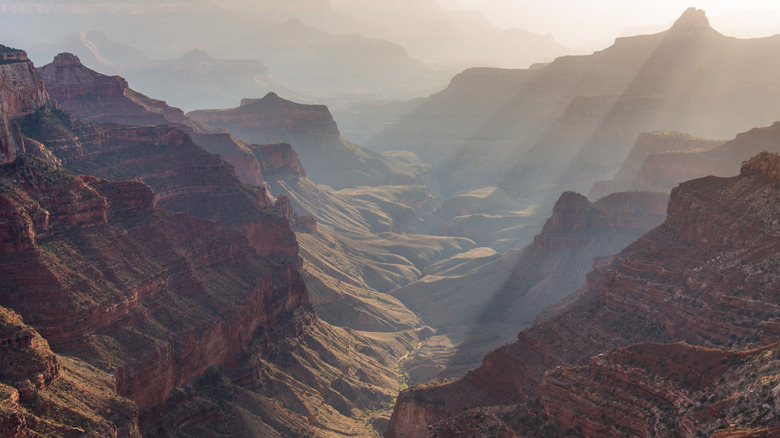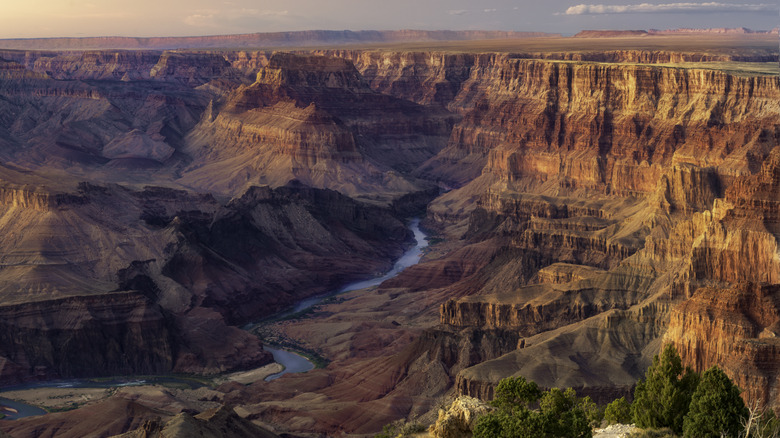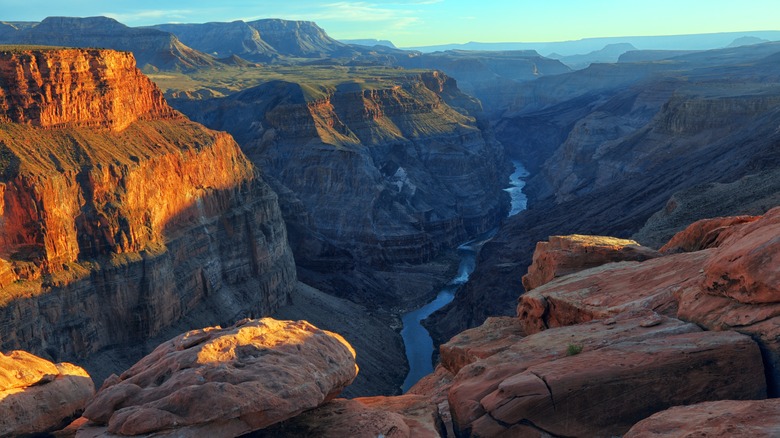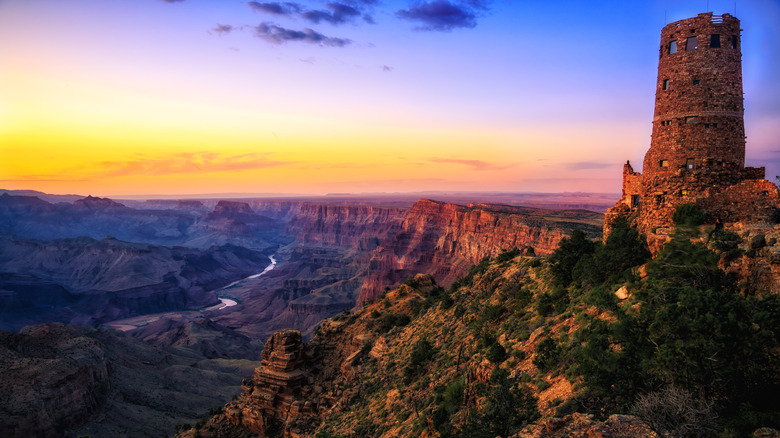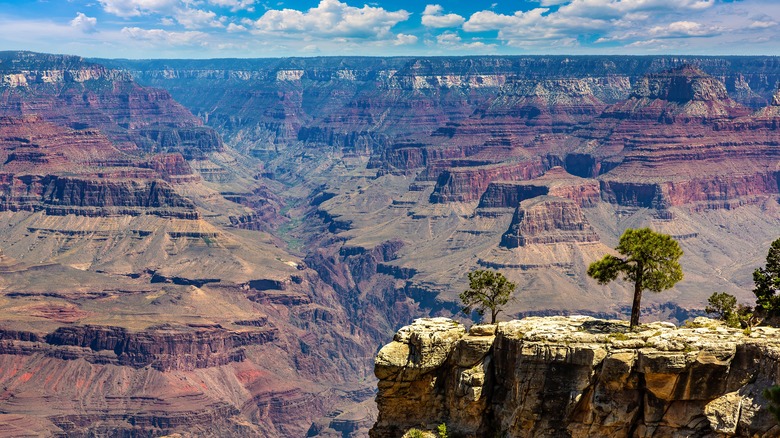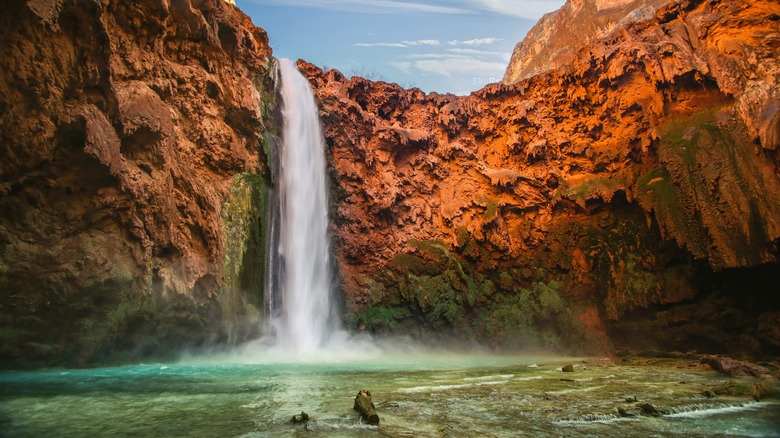The Best Airports For Visiting The Grand Canyon, Depending On Your Vacation Goals
So the Grand Canyon is pretty big, right? Like a mad colossus just started hacking away at the rock with a mountain-sized sword and left a jagged, criss-crossed cleft in Earth's face. And at 277 miles long and 18 miles wide at its widest, it's not only staggering to behold up close, but impossible to visit all at once. You've got to pinpoint certain areas of the canyon and build your itineraries around them. Typically, this includes the popular South Rim, the less popular North Rim, the small East Rim, Grand Canyon West (sometimes called West Rim), or off-the-beaten-path stretches like the ghost town, Tuweep. Trips to each one benefit from arriving via a different airport, although some airports are better overall choices no matter what.
First off, there's a difference between the Grand Canyon National Park and the entire Grand Canyon. The national park constitutes one circular area of the canyon's east-of-middle section, and includes the South Rim and North Rim. The rest of the canyon falls outside the national park. Two parts — Grand Canyon West and the Havasu Falls area — fall under the management of the Hualapai Nation and the Havasupai tribe, respectively. This doesn't affect access to those areas, but it's something to consider when determining what kind of Grand Canyon trip you want.
Some sections of the canyon, like Grand Canyon West, are easily incorporated into a Las Vegas trip and best accessed via the Las Vegas Harry Reid International Airport in Nevada (LAS). Other choices are less clear, but boil down to Flagstaff Pulliam Airport, Phoenix Sky Harbor International Airport, Prescott Regional Airport, Sedona Airport, and a couple tiny airport options.
Visiting the Grand Canyon's popular South Rim
Hands down, when folks think of visiting the Grand Canyon they're almost certainly thinking of visiting the South Rim, whether they realize it or not. If you want to visit the South Rim, you have to approach the canyon from the — surprise, surprise — south. All roads to the South Rim eventually culminate on one, single entrance off of Route 64 that leads to parking, the Grand Canyon Visitor Center, the Grand Canyon Village tourist hub, a network of hiking trails, a bajillion lookout points like the justifiably famous Mather Point, and more. It's no wonder that the South Rim gets 90% of the park's visitors every year. It's also open year-round, unlike the North Rim.
So, it makes sense that visitors heading to the Grand Canyon for the first (and possibly only) time will want to hit up the South Rim, no matter that all sections are visit-worthy. Also, if you're only in the area for the Grand Canyon and nothing else, the South Rim makes sense. On that note, Flagstaff Pulliam Airport (FLG) is your closest, best option considering the frequency of flights and size of airport. It's just 90 minutes away by car along I-40 and the aforementioned Route 64. Phoenix Sky Harbor International Airport (PHX) is another option. But at three and a half hours away, it's not really suitable for a meaningful in-and-out Grand Canyon trip and would require staying overnight in the canyon. The smaller Prescott Regional Airport (PRC) is another option for national travelers, at two hours away.
Circumventing crowds (and the canyon) to reach the North Rim
Sitting opposite the Grand Canyon's South Rim is the aptly named North Rim. This doesn't mean that you can stand at the North Rim and wave at people on the South Rim — they're not that close. It means that North Rim visitors have to do what 19th-century pioneers couldn't easily do: Go around. Access to the North Rim generally flows from the south, bypasses the South Rim, and circles counterclockwise around the eastern edge of the canyon. In practical terms, this means that your 90-minute trip from Flagstaff Pulliam Airport (FLG) becomes four hours. This is probably why the North Rim gets only 10% of the park's visitors every year. It's also only open from mid-May to mid-October. But you can also use the North Rim as a launching point to visit national parks like Bryce Canyon and Zion National Park. So, pick your poison.
All in all, the North Rim is perfect for repeat Grand Canyon visitors or those who want a less conventional Grand Canyon experience. Aside from the longer drive to the North Rim from FLG, the drive from Phoenix Sky Harbor International Airport (PHX) gets bumped up to six hours, and the drive from Prescott Regional Airport (PRC) to nearly five and a half hours. This means that, aside from FLG, the North Rim might be best accessed from Harry Reid International Airport (LAS) in Las Vegas, a little less than five hours away. This option suits those wanting a Vegas excursion as well.
Getting to the canyon's small, lesser-known East Rim
Remember we said that you'd have to circumvent the Grand Canyon's eastern side, counterclockwise, to get from the South Rim to the North Rim? Well, right in the middle of the South and North rims sits the East Rim, accessible from the very road — Route 64 — that you'd drive along to travel between the South and North Rims. But it's a mistake to envision the East Rim sitting at the very, easternmost part of the Grand Canyon's entire west-east length. The East Rim is only a bit over 30 minutes by car from the South Rim, making it more of an extension of the South Rim than anything else. The East Rim has all the lookout points and hiking trails you'd expect, plus a couple of cool ruins like the Desert View Watchtower built in 1932.
All in all, given its close proximity to the South Rim and its small size, the East Rim makes for a perfect addition to those visiting the South Rim. Or it makes a good stop-off on the drive from the South Rim to the North Rim. Neither statement changes the East Rim's accessibility, however. You'll have to use the same airports as before, but it makes sense to limit your choices to those three airports closest to Grand Canyon's south side: Flagstaff Pulliam Airport (FLG), Phoenix Sky Harbor International Airport (PHX), or Prescott Regional Airport (PRC).
Making the trip to Grand Canyon West
Trips to the Grand Canyon really diverge when taking Grand Canyon West into account, sometimes called the West Rim. Grand Canyon West is separate from the South Rim, North Rim, and East Rim cluster, both physically and legally. It's on Hualapai land, which means national park passes and perks don't apply. There's some unique visitor attractions in Grand Canyon West, like the glass-floored, U-shaped Grand Canyon West Skywalk 4,000 feet above the canyon bottom. Arizona's Joshua Tree Forest is also nearby, and less than 30 minutes away by car. The West Rim also offers zip-line fun across the smaller Quartermaster Canyon within the Grand Canyon.
Besides these options, there's obviously Las Vegas, which is basically next to Grand Canyon West on the other side of Lake Mead — only a two-hour drive. This makes Las Vegas' Harry Reid International Airport (LAS) the no-brainer choice for visiting Grand Canyon West. You could do all of Vegas' usual gambling and show-seeing stuff, or even do something off-beat like visit an actual chunk of the sunken RMS Titanic in the pyramidal Luxor Hotel and Casino. But even if you're going to fly into Vegas and bypass the city's offerings for whatever reason, LAS is still the only reasonable airport choice for Grand Canyon West. You could — could — fly into Grand Canyon West Airport, located a mere half a mile away from the West Rim. But being a smaller airport about the size of a diner, flights are extremely limited. Bear that in mind when planning your trip.
Trekking off the beaten canyon path: Tuweep and Havasu Falls
Finally, we end on a couple unconventional Grand Canyon destinations that might affect your airport choice. First, we've got the truly challenging and adventurous option: Tuweep. Known as the "back door" to the Grand Canyon, Tuweep is one of those places where incautious, backpacking vloggers might accidentally record their last moments. You need an advanced permit to enter, backup fuel for vehicles, there's no water, lodging, cell service, and much more. To get here, it's easiest to drive in from Fredonia, Arizona via route 389 on the north side of the Grand Canyon. And getting to the general Fredonia area? Use Harry Reid International Airport (LAS) in Las Vegas again, perhaps tasting a bit of civilization before wandering into the wilds.
There's another hard-to-reach place on the south side of the canyon that offers a truly unique, beautiful experience: Havasu Falls, which connects to other nearby falls like Mooney Falls and Beaver Falls. Reaching Havasu Falls requires a true trek, starting with Route 66 on the south side of the Grand Canyon. Drive to Peach Springs, then up Indian Route 18 to a parking lot, and then make an 8-mile hike to Supai Village. From there, you can reach the waterfalls by mule — yes, mule. The village and whole region belong to the Havasupai tribe, and you need to make a reservation that doubles up as a permit. Naturally, visitors should abide by a strict "Leave No Trace" rule. Like the rest of the Grand Canyon's south side, Flagstaff Pulliam Airport (FLG) is the best way to reach Havasu Falls, at less than two hours away by car.
